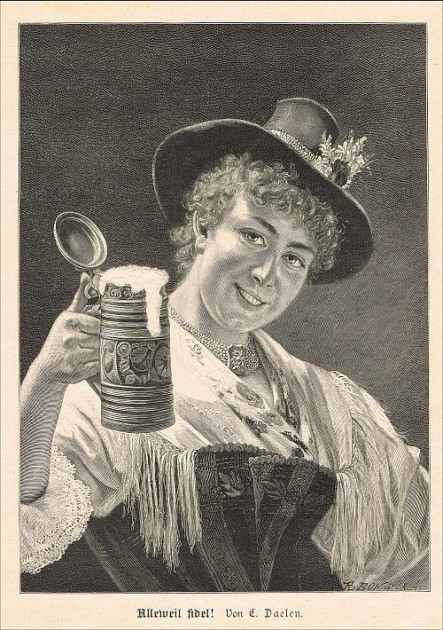
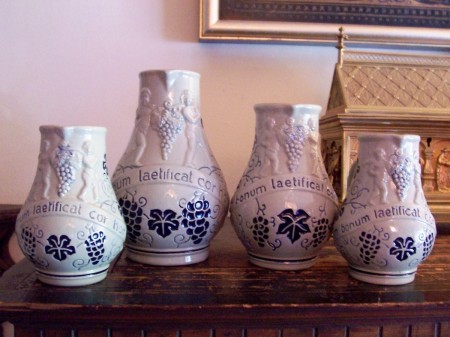
A grouping of individual (versus commercial) small salt glazed wine jugs, made by “Wick-werke.” Two quarter liters and one each, half liter and liter. Circa 1930-50. {FWTD]
Wick-Werke – German pottery stein makers. Took over the firm of Merkelbach and Wick in 1921.
For info on some of this firm’s wine items, please see: http://www.steveonsteins.com/1-3
Also see: http://www.steinmarks.co.uk/pages/pv.asp?p=stein1
WICKER, WOVEN, THEN LACQUERED FIND JUDY’S STEIN ARTICLE
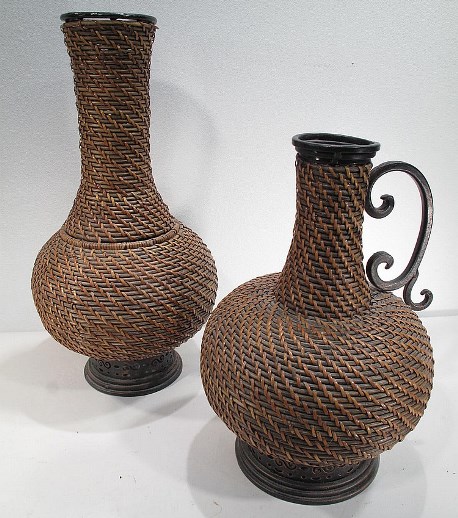
Wiesbaden 1770-1795 –– City or town of major fayence stein production.
For more info, see: http://www.thepatriotexchange.com/pss/hisfai.htm
Wieseler, Theodor – Late 1800’s German beer stein distributor in Nuremberg. His mark was a simple T W. See: http://www.steinmarks.co.uk/pages/pv.asp?p=stein1
▼ A stoneware .5 liter character stein of one of the Nurnberg old wall towers.
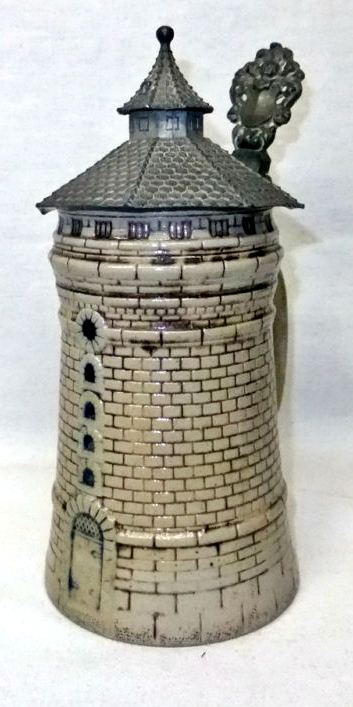
WIINBLAD, BJORN – A “Deco” designer for Rosenthal Porcelain.
![ROSENTHAL BJORN WIINBLAD [designer - quest.]STUDIO ART GERMAN LIDDED BEER STEIN SET ( 2 )](http://www.steveonsteins.com/wp-content/uploads/2011/01/ROSENTHAL-BJORN-WIINBLAD-designer-quest.STUDIO-ART-GERMAN-LIDDED-BEER-STEIN-SET-2--450x259.jpg)
Wildman / men – see full page on this subject:
http://www.steveonsteins.com/the-green-man-vs-the-wild-man
See Also: Wild Woman
▼ Wildman on a cut to clear Czech vase – well I guess you could drink out of it or use it as a personal (tat able) wine server. cC. 1970.
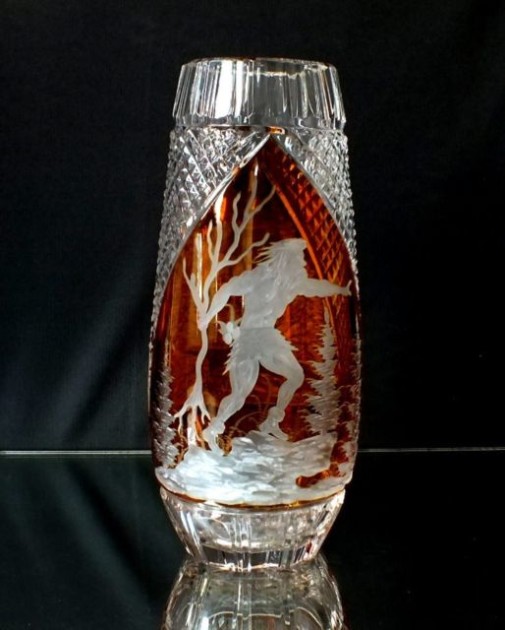
▼ Wild Woman Holding a Shield with a Lion’s Head, Martin Schongauer, German 1448-1491
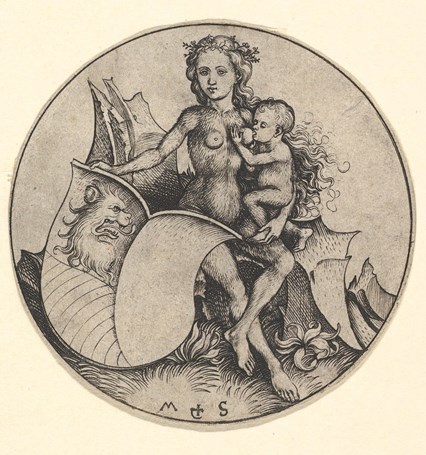
Willet’s Manufacturing Co. USA – A firm in New Jersey maker of Belleck porcelain vessels.
See: http://www.steinmarks.co.uk/pages/pv.asp?p=stein345
For the history on the original Belleek Pottery
See: http://en.wikipedia.org/wiki/Belleek_Pottery
▼ A Princeton University beer mug with its tiger holding the Coat of Arms.
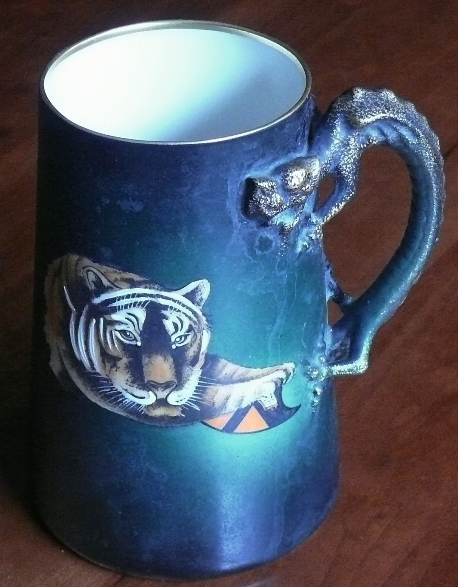
William Tell – A Swiss legend of a father who shots an apple off his son’s head. Scenes from which are reproduced on steins ranging from V & B Mettlach, to the “mud steins.”
▼ A plain gray Westerwald stoneware (“mud stein”) showing the story.
Wilner, Bruder (Brother[s]) –Austrian majolica manufactures located in Teplitz.
▼ .25 liter beer mug that I think somewhat resembles designs used by Roystrand in Sweden. Perhaps he was employed there for a time -= unknown to me.
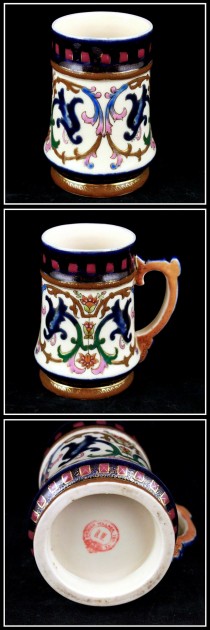
▼1/2L. Relief Verse and floral. Similar design on Rorstrand piece.
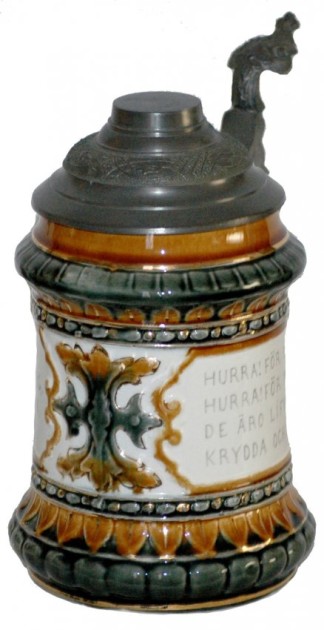
Windmill cups – Shown ▲: 4 & 7/8th inches high, very detailed engraving all over the piece. Very nice, but the eBay seller (2011, and still listed in August, 2012) wanted a lot for the small size I thought. For more on”windmill cups ” see: http://www.steveonsteins.com/windmill-cups-these-are-wager-cups-new-8-25-2012
These kinds of cups, mostly seen in silver silver, and some enameled and cut glass with bodies of molded brass or chached silver – were usually USED as follows: One of the drinkers (usually there were several involved) would invert the cup and would fill the cup up with whatever was the home’s choice of schnapps or liquor. Then he’d spin the windmill wanes by using his fingers, this gets the vanes started in rotation, he then blows into the pipe getting the vanes up yo their full speed; he then had to drink the contents of the cup before the vanes stopped going around. If not then he to pay some type of penalty, which was determined by which number the pointer (not a clock even though it looks like one) stopped on.
There are all sorts of variations of ‘the game’, such as buying the next round of drinks if one could not drink all in time before the wanes stopped (as some of these cups are rather large or the liquor hard to swallow), or if any booze was spilled, or to paying money / the bar tab based on the number the pointer stopped on; to betting on who can come closest to any pre-picked number. The list “of games” is pretty much endless and are very similar to the “dice cup” games, of which there are hundreds. The wind-flag, the rooster (I think) on the thatched roof, and little figures on the bannister staircase, must have some long forgotten significance – but by the late 1700’s all of the cups evolved to almost always include them. I have one without the cock (not unusual) and I have seen a photo of one without the flag , I can’t say if had been broken off, but I believe so.
Some of these windmill cups have been converted into bells (as have wedding cups) and the world’s bell collectors love them!
▼ An old Dutch silver piece, 4 & 7/8th inches high with a newer clapper put in it. Missing the pointer hand also. [FWTD].
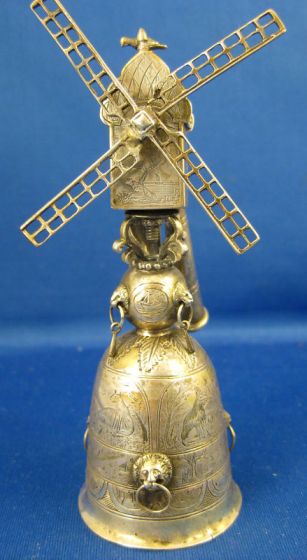
▼ Two Dutch windmill cups, by the same maker, that were made as bells. These could be used for either purpose I guess.
A silver “windmill cup” with no blow pipe.
This one comes without the blowpipe or bird on the roof, also a bell.
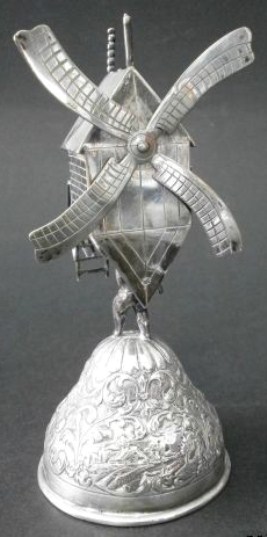
WINDOW MEASURE. –
▼ COPPER 9 IN TALL WITH VISABLE LIQUID WINDOWS
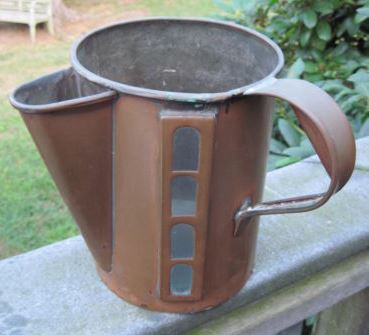
Wine cup – European wine cups do not normally have handles. They are mostly small beakers but for every rule there are exceptions!
▼ Theresienthal wine cup with handle and a “star print” on the front.
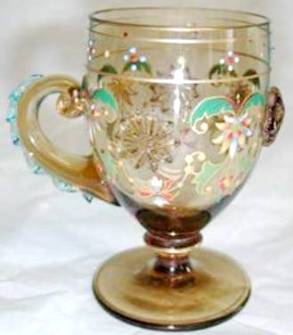
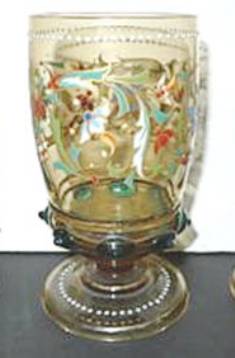
Wine flask, German: This style flask or liquid carrier in pewter, pottery or fayence is called a “Schraubflasche.“ Shown above ▲: A newer pewter example of a style popular in the 1600- 1700’s. Versions with the niches and bannister style supports are hard to find.
For lots more of these, see: http://www.steveonsteins.com/schraubkanne-schraubflasche-in-the-s-m-t
Wine jug (French) – This very bulbous style is called a “Croc au vin.”
▼ A two liter pewter relief jug with “Silenus” (not Bacchus) along with two Coat of Arms. Obviously a marriage present. Circa: mid 1700’s. [FWTD]
Wine servers or pitchers (Individual) , larger ones are sometimes called jugs, (German )- Usually made of saltglazed stoneware from the Westerwald region, and decorated by two young boys carrying grapes on a stick.
See: The boys with the grapes. What is that all about? = http://www.steveonsteins.com/1-3
▼ An older stoneware example. Circa 1870. Germania and “the two boys” in relief. [FWTD]
Wine jug or pitcher, (individual) German / commercial variety) – The custom of providing a stoneware wine pitcher to the table to keep the wine cool, became real popular after WWII when the tourists came to the German wine country. They are found in many sizes and designs. Most found are the 1/4 and 1/2 liter.
▼ This one is from “The Bremer Ratskeller” and shows a baby Bacchus sitting on a barrel. It comes in different colors. [FWTD]
Wine jug or pitcher, (individual) from other countries. Below are a few other types of European and Asian wine servers / pitchers are shown below just for the new collector’s edification. These, like their beer server counter-parts can make for a fascinating collection when grouped and displayed well.
(Larger Non- individual wine servers from other countries.) These do include “claret” bottles which have their own distinct form and are included in the section just below . ▼.
Need photo of clarets
- WINE – PORTER [CARRIER] BOHEMIAN COPPER CIRCA LATE 1600’S 21 INCHES TALL-[FWTD] INV. NO. XXXX-2321-O415
Wine jug or pitcher, character, Hungarian –
▼ Approx .0ne liter, pottery relief server with a fayence type glaze. Circa 1880- 1910. There are several designs of this man; as they have been made for years.
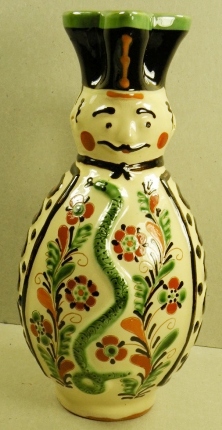
Wine pitcher (standard size) Non- individual
▼ A claret wine jug. Circa 1890. Pewter mounts by J. Lichtinger, Munich, and the glass was most likely provided by Theresienthal. Thieseare sometimes called “decanters” which is would have been the old usage.
▼ Copper wine server, 14 inch tall , chased and hand engraved with armorials Bohemian, CA. -1750-80. [FWTD]
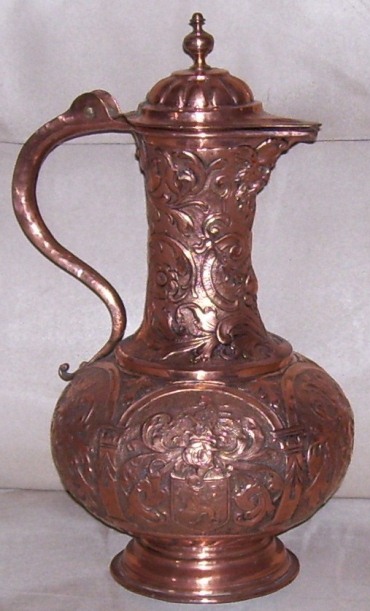
▼ An exceedingly well done claret jug done in Bronze. 12.5 inches tall . Ca. 1850-70. No marks Only Stamped on bottom GESETZLICH GESCHUTZT [FWTD]
Photo coming soon of this piece polished. (12/14)
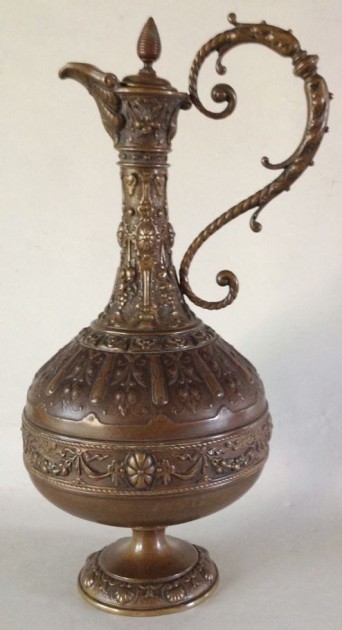
WINE – PORTER [CARRIER] BOHEMIAN COPPER CIRCA LATE 1600’S 21 INCHES TALL-[FWTD] INV. NO. XXXX-2321-O415
![CR- WINE PORTER [CARRIER] BOHEMIAN COPPER](http://www.steveonsteins.com/wp-content/uploads/2013/07/CR-WINE-PORTER-CARRIER-BOHEMIAN-COPPER-310x630.jpg)
Wine stein – A “stein” made for use in drinking wine and/or those made to celebrate wine drinking. I estimate at least 10% of all so called “beer steins” made in Germany were made to celebrate the drinking of wine. (There is lots of disagreement on that statement in SCI, but they are mostly all beer drinkers.)
▼ A semi- character Dwarf / Gnome beer stein celebrating the harvesting of the grapes. An unknown maker. One liter in size.
For more info on the basis of this scene please see the page, this web site: “The boys with the grapes. What is that all about?” = http://www.steveonsteins.com/1-3
Wine warmers – Originally made to suspend and serve water out of , but the water was so bad in Europe, these could and were used later to sit in / or over fire to warm wine. I have seen many with dried wine residue left cooked inside them
▼1th century, Cast Bronze kettle [FWTD]
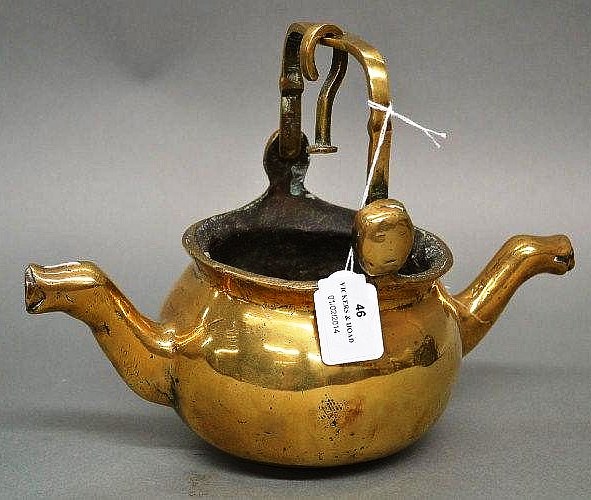
cloister’s photo due here
▼ Most likely just for water or cold wine as pewter would melt over a good lasting fire. 1720-?
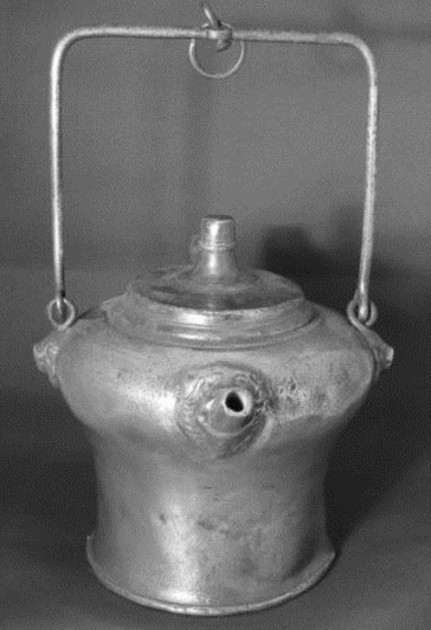
▼ Individual, small bronze wine server, 3.5-inches-tall , most probably from India- Ca.mid to late 1600’s.
Wine witch – Slang term for this very new molded ceramic wine server. I am not certain why the face on the one shown is darker than her body – on the one I have it is the same color. [as in Stephen Smith Collection]
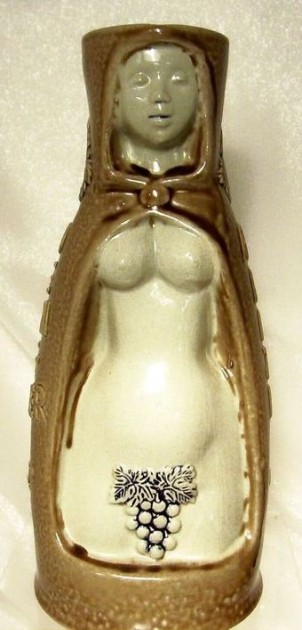
Winged wheel (on steins) – Symbol for the Railroad (Eisenbahn) Service and Military Railroad when seen on Reservist steins.
▼ .5 liter pottery with hand painted scene.
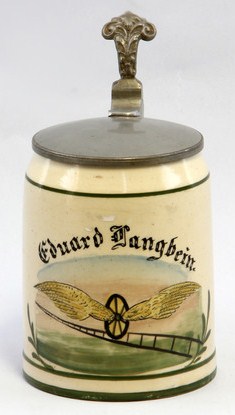
Winterthur (Factory) Fayence – A city in the canton of Zurich, in northern Switzerland. During the 16th and 17th centuries Winterthur was the most important pottery center in Switzerland.
▼ 3/4L, Fayence with floral design. [RFA]
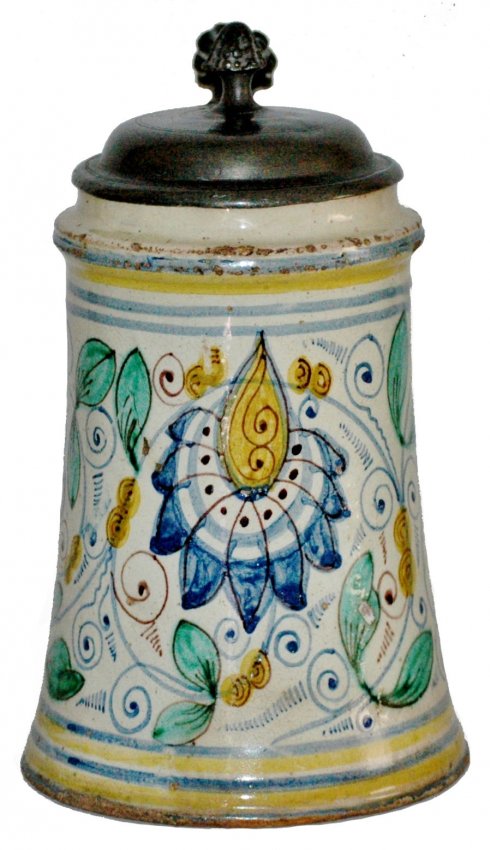
Winterthur Museum – A famous museum located in Delaware, USA. Not known for its stein collection but its furniture ! See: http://www.winterthur.org/
Wired stein – Twisted wire around the molded indentations on the body. Very scarce stein to acquire. May also be called a “caged glass.”
Wise and foolish virgins, The – A famous biblical parable, from the Gospel by Matthew, often told on Ivory steins such as below ▼. It was one of the most popular parables in the Middle Ages, with enormous influence on Gothic art, sculpture and the architecture of German and French cathedrals.
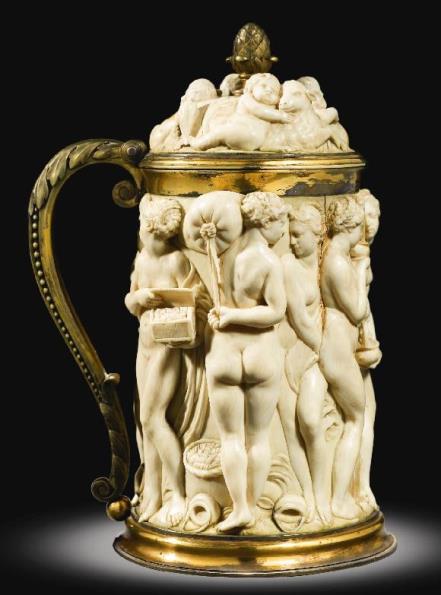
Wittelsbach – A porcelain stein / mug maker in Bavaria. Shown: A six inch tall hand painted porcelain portrait mug. Beautiful workmanship.
See: http://www.steinmarks.co.uk/pages/pv.asp?p=stein1
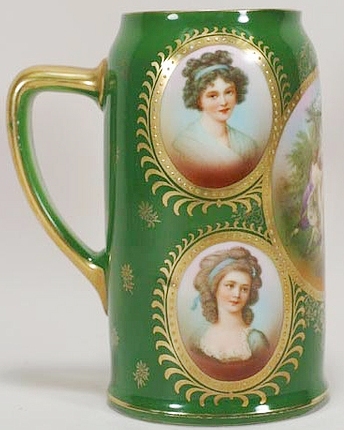
Witty steins (humorous sayings) –
▼ An unmarked English pottery mug. It has “The Last Drop” logo on the inside of the mug.
See also: “Motto ware.”
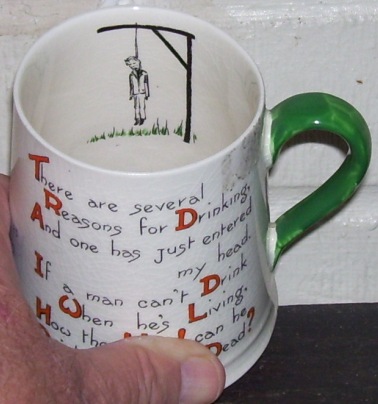
W.M.F. – (Württembergische Mettalwarenfabrik) The largest silver plating and other metal manufacturers in Germany in the 1800’s. it was larger than Elkington & Co. in England. The firm was recently sold (1990’s?) and prior to that time they were still making drinking vessels.
In the early 1900’s they bought V & B Mettlach un-lidded steins, attached one of their silver plated lids and sold them through their own catalogs.
See: http://www.steinmarks.co.uk/pages/pv.asp?p=stein551
▼ Glass stein, .5L, blown in WMF’s glass making factory, wheel cut and engraved, silver lid, gilded. Ca 1880. [TSACO]
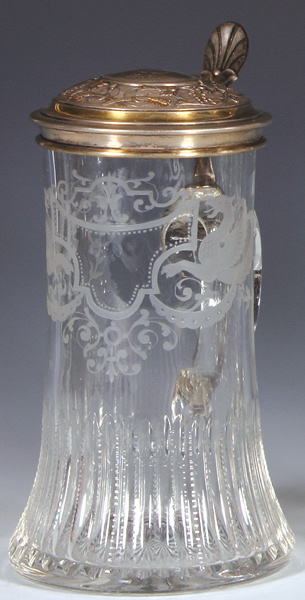
▼ A very nicely done .5 liter Art Deco cut glass stein with silver plated lid by WMF. The glass body was blown and cut at WMF’s own glashütte.
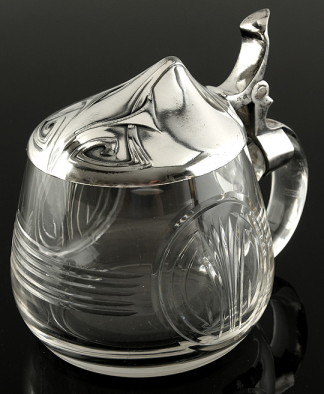
▼ .5L, blown, Art Nouveau, silver-plated lid, handle & base.
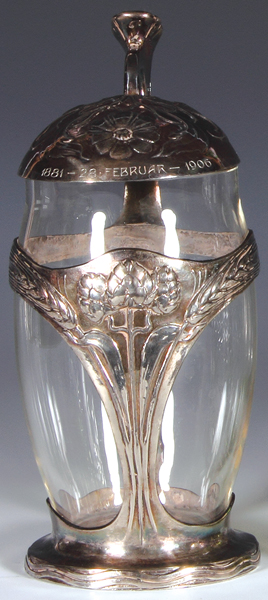
W.M.F. was (and still is) famous for their line of copper drinking vessels too, mostly Art Nouveau/ Jugendstil Claret jugs servers and sets as shown below ▼.
![WMF SERVER CALED A DECATER BY A GERMAN LOST IN TRANSLATION [Q] EBAY 12-10](http://www.steveonsteins.com/wp-content/uploads/2013/01/WMF-SERVER-CALED-A-DECATER-BY-A-GERMAN-LOST-IN-TRANSLATION-Q-EBAY-12-10-217x450.jpg)
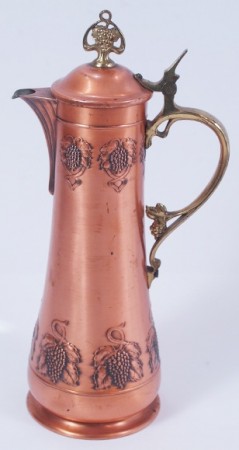
“Wohl Bekomms” – German phrase meaning roughly “Receiving good cheer.” [American slang definition: “Having a party!” or “Having a blast!”]
▼ .5L pottery relief. Ca. 1890.
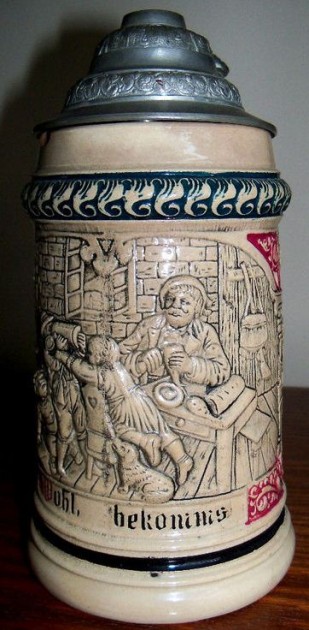
Wollenweber – A very well known Bavarian silver-smith in the late 1800’s. As far as I can tell, he had “the only” Royal Warrent for making the Bavarian King’s household’s silver pieces at that time.
▼ A marked Wollenweber ,17 inch tall pokal of .800 silver.
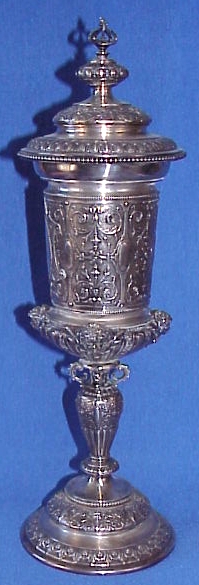
Wooden / wood steins – Steins produced from trees, mainly done is Scandinavia along the Baltic Sea, or Bavaria & Austria – Hungary where the raw material was readily available.
Some earlier ones with cut out staves and inlaid pewter designs are called “Lichtenhainers.” These “Daubenkrugs” were made in the Thuringen region of Germany in the late 1600’s and 1700’s.
For much more on wooden steins, see: http://www.steveonsteins.com/wooden-steins [pages 1 to 3]
▼ A large. two liter (?) carved and chipped stein from Estonia. NOT NORWAY! Circa 1800 [FWTD]
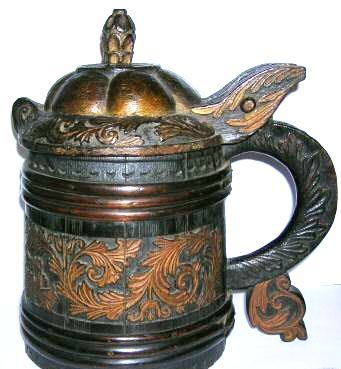
Wooden base steins – If done with silver or plated metal, it is most likely an “Old Sheffield Plate” piece.
See more under “Old Sheffield Plate” in the Compendium.
▼ An English O/S/P pint tankard. Circa 1780, with a wooden base. Notice the seam line on the side of the stein, indicative of O/S/P pieces.
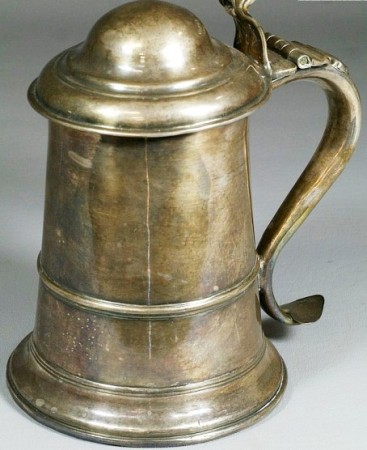
Wood, Arthur – English ceramics firm, made a large variety of drinking mugs. Most famous for “Toby Mugs.” Shown: Toby Mug, 11 inches tall, “Martha Gunn” Toby Mug; a replica of 1770 piece, by Wood & Sons – Ltd. Edition.
See: http://www.steinmarks.co.uk/pages/pv.asp?p=stein1

Worcester Silver Co., New York and London (Sheffield made?) – Sorry folks , but I can not locate any info on this manufacture other then a few items for sale on eBay. I tried under silver and under pewter which is what this stein is made from. Anyone have any ideas? With offices on both shores one would think there would be “Boo-Coos” of info!
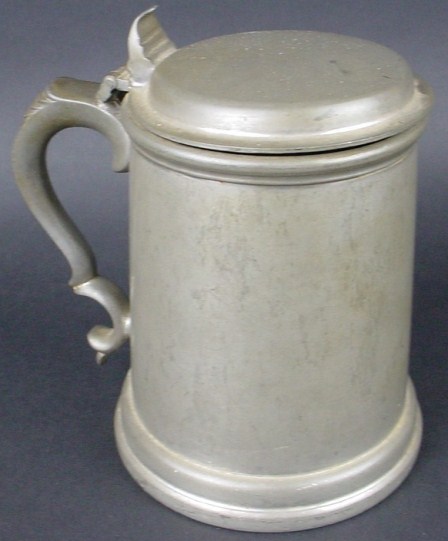
▼ Detail of “Double C” handle done in an older style and with molded chevrons on the handle.
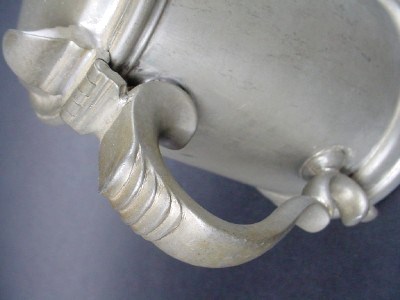
▼ Detail of hand scribed mark: “New York and London.”
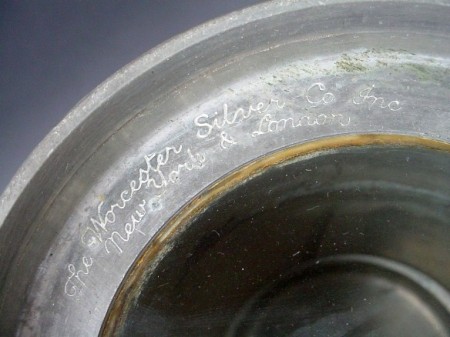
World War One Steins – European: “The Central Powers,” warring factions in World War I (1914–18), composed of the German Empire, the Austro-Hungarian Empire, the Ottoman Empire, and the Kingdom of Bulgaria. This alignment originated in “The Triple Alliance,” and fought against the Allied Powers that had formed around the Triple Entente.
See also: Alliance steins in this site’s Compendium.
▼ A .5 liter pottery with a PUG scene of the four leaders of the Central Powers.
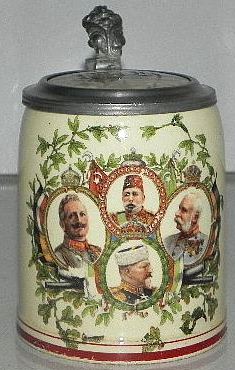
World War One Steins – AMERICAN – Those, as above, made for American Military units, BUT after the war was over.
▼ WWI – Photo Transfer on a soldier’s stein [RFA]
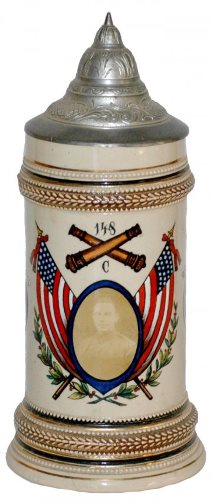
▼ WWI -US Hdq 127 Inf 32nd Div Military Stein. [RFA ]
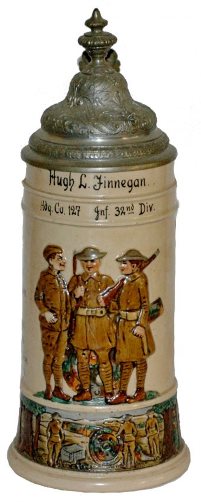
Wormed glass (Air twist stems))- See: “Twisted Stem”; “Air Twist”; & “Ribbon Stemmed”, all in this site’s Compendium.
These glasses were also known as “wormed glasses” in the mid 18th century England due to their appearance; almost as if a worm had crawled through the glass leaving a trail behind it where it had “eaten” the glass.
Note: I would like to buy these but only at the 11 inch size only!
▼ A non English 11 inch blown and engraved clear glass roemer made by Josephinenhütte, Germany. Ca. 1890
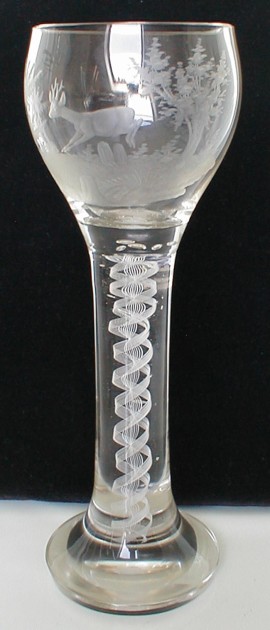
Wrestling steins – Not too popular a sport in Germany, as noticed by the fact that these steins are pretty hard to find.
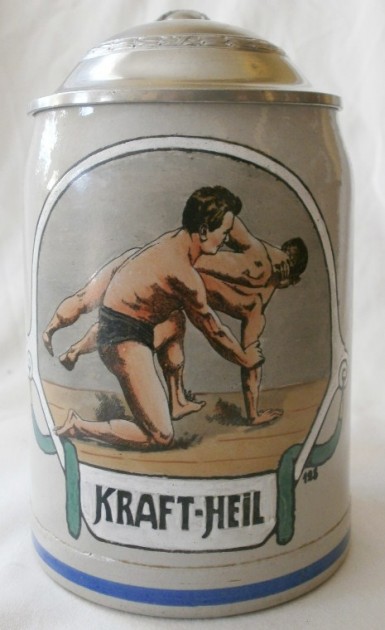
Wrigglework — Zigzag engraving, achieved by moving the burin in a rocking movement; or a roulette, or wheel, with a finely crimped edge. Popular in the late 17th and first half of the 18th centuries, especially on pewter.
▼ Pewter tankard with a detailed Wrigglework pattern, a brand new copy! So be careful out there folks. Luckily this one is stamped 95% = which is a give away for newer pieces of pewter!
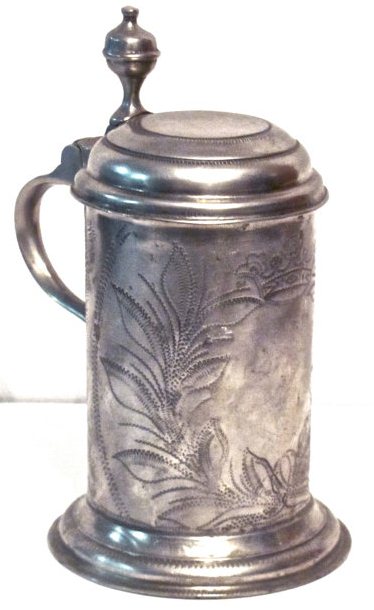
Wrisbergholzen 1735-1834 – City or town of major fayence stein production.
For more info, see: http://www.thepatriotexchange.com/pss/hisfai.h
Writhen (body) – Used in conjunction with glass items, and sometimes metal referring to the body shape . It means twisted or contorted; also made or shaped by intertwining or plaited.
Editor’s note: I had a nice photo of an antique British glass vessel but the English owner wanted too many technical restrictions for me to use it .(no wonder we had to bail them out of the wars twice after we beat them twice. Previous deals with other English antique dealers verify that as a group, they have been and still are a bunch of a A-H’s! I will find another example.
Wrought metal (product) – Component made by hot or cold deformation of a cast product, removing the original cast structure.
W. S. – Unknown maker.
▼ Pottery stein, (majolica?) 1. L, relief, marked “W. S.”, 40, figural inlaid lid, seldom seen. Ca. 1880.[tsaco]
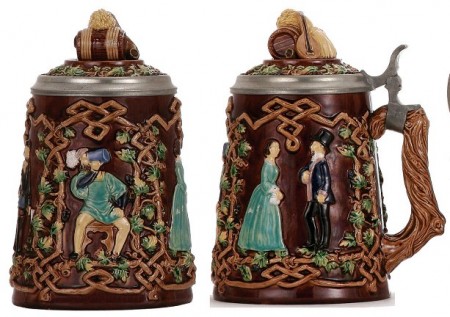
Wurttemberg – A major state of Germany back in the stein production days. Now it is Baden-Wurttemberg, two of the old states merged together. Shown: .5 liter pottery stein with hand painted Coat of Arms of old Wurttemberg.
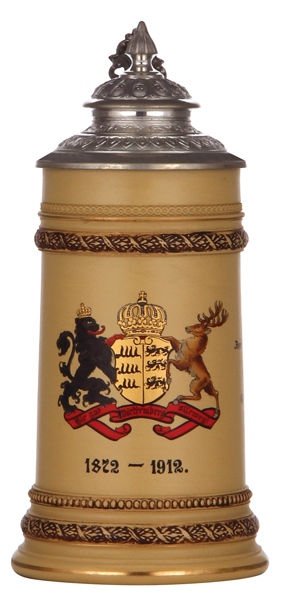
Württembergische Mettalwarenfabrik – See: WMF above.
Wynand – A little known stein maker. Shown: An Art Deco, 2.0 liter server. An example of why he was probably so little known! I think it is ugly! [TSACO]
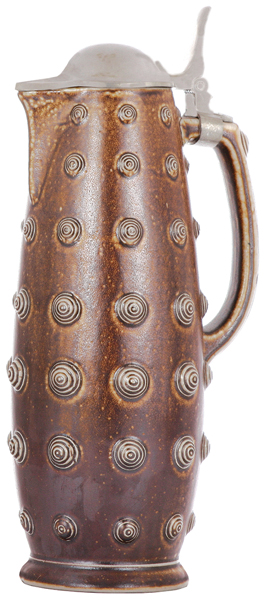
▼ An almost matching stein to go with the server. One liter in size. (And still ugly!)
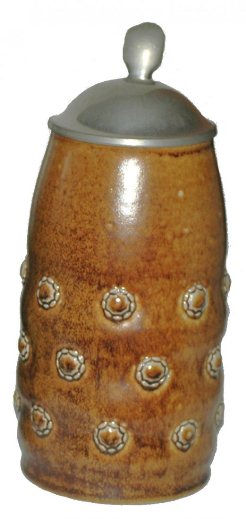
[END – SP104 – 60 – R5 [+]
 “My girlfriend thinks I’m a stalker. Well, she’s not exactly my girlfriend . yet!”
“My girlfriend thinks I’m a stalker. Well, she’s not exactly my girlfriend . yet!”

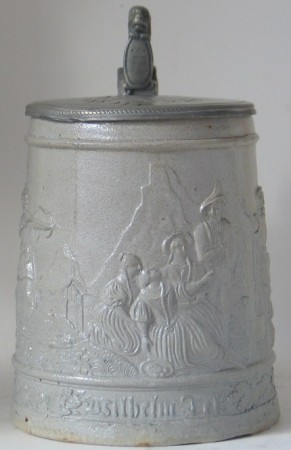
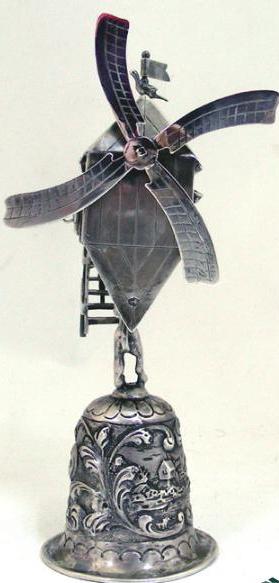
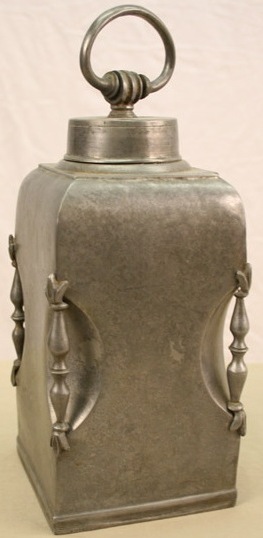
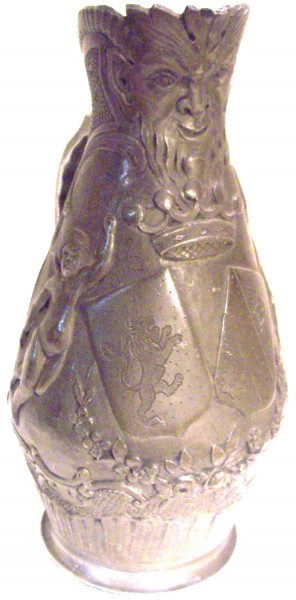
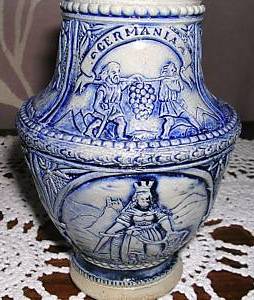
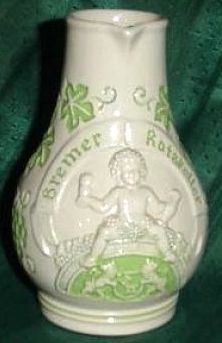
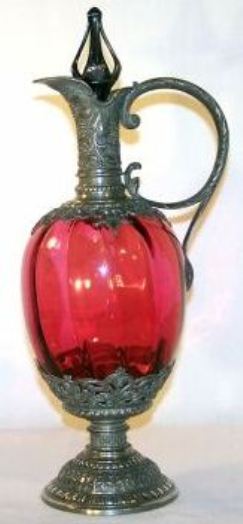
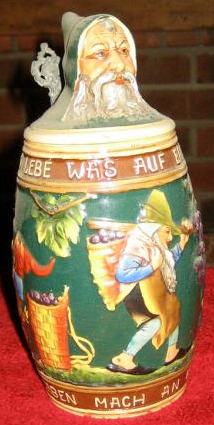
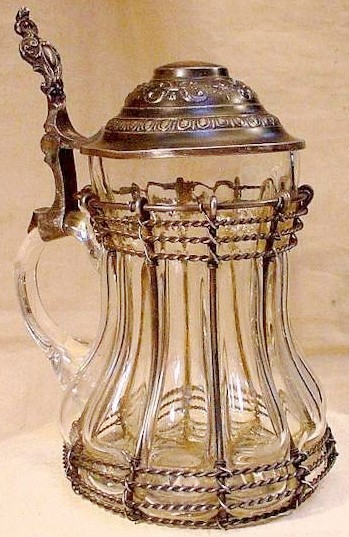
![1W WITTY [HUMEROUS]' MUGS](http://www.steveonsteins.com/wp-content/uploads/2010/07/1W-WITTY-HUMEROUS-MUGS-.jpg)
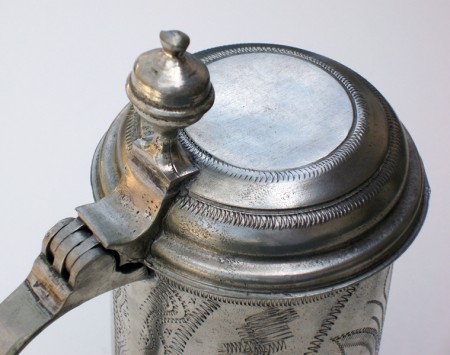
Leave a Reply